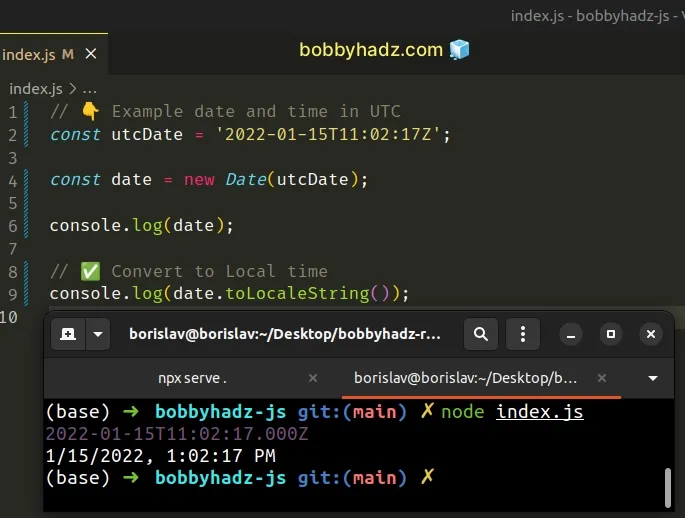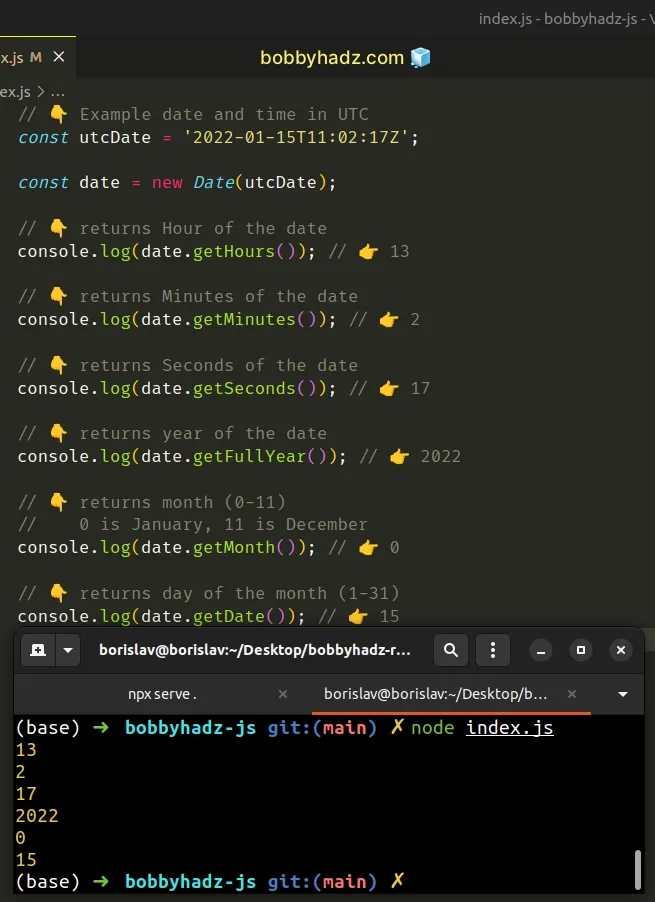Convert UTC/GMT to local time and vice versa in JavaScript
Last updated: Mar 5, 2024
Reading time·7 min

# Table of Contents
# Convert UTC/GMT to local time using JavaScript
Use the Date() constructor to convert UTC/GMT to local time.
Passing a date and time string in ISO 8601 format to the Date() constructor
converts the UTC date and time to local time.
// 👇️ Example date and time in UTC const utcDate = '2022-01-15T11:02:17Z'; const date = new Date(utcDate); // 👇️ "Sat Jan 15 2022 13:02:17 GMT+0200 (Eastern European Standard Time)" console.log(date); // ✅ Convert to Local time console.log(date.toLocaleString()); // 👉️ "1/15/2022, 1:02:17 PM"

Note that GMT and UTC share the same current time.
The difference between them is that GMT is a time zone, whereas UTC is a time standard and is the basis for time zones worldwide.
UTC and GMT don't change for Daylight Saving Time (DST) and always share the same current time.
Date() constructor converts the UTC/GMT date and time to local time.The time in the UTC string from the example shows 11:02:17 UTC. Since my time
zone is UTC +0200, the result shows 13:02:17.
Note that the UTC date time string should end with a Z to be considered valid
ISO 8601.
If the string doesn't have a Z at the end, add it using the addition operator,
e.g. isoStr + 'Z'.
You can also get an ISO 8601 date time string by calling the toISOString()
method on a Date object.
// 👇️ "2023-07-25T12:51:25.173Z" console.log(new Date().toISOString());
We used the toLocaleString() method to convert UTC to locale time in the example.
const utcDate = '2022-01-15T11:02:17Z'; const date = new Date(utcDate); // ✅ Convert to Local time console.log(date.toLocaleString()); // 👉️ "1/15/2022, 1:02:17 PM"
The comments above illustrate the formatting if the methods are run with a time zone of Eastern European Standard Time.
The output you see will likely be different and it depends on your default locale and default time zone.
# Get date and time components according to local time
You can use any of the get* methods to get any of the date and time components
of a date according to the visitor's local time.
// 👇️ Example date and time in UTC const utcDate = '2022-01-15T11:02:17Z'; const date = new Date(utcDate); // 👇️ returns Hour of the date console.log(date.getHours()); // 👉️ 13 // 👇️ returns Minutes of the date console.log(date.getMinutes()); // 👉️ 2 // 👇️ returns Seconds of the date console.log(date.getSeconds()); // 👉️ 17 // 👇️ returns year of the date console.log(date.getFullYear()); // 👉️ 2022 // 👇️ returns month (0-11) // 0 is January, 11 is December console.log(date.getMonth()); // 👉️ 0 // 👇️ returns day of the month (1-31) console.log(date.getDate()); // 👉️ 15

All of the get* methods return the date or time component according to the
visitor's local date and time.
Note that the Date.getMonth() method returns the month of the specified date as a zero-based value (0 = January, 1 = February, etc.)
If you need a complete list of the Date.get* methods, visit the
MDN docs.
You can use these methods to format the local date and time in many different ways.
Here is an example that formats the local date and time as
YYYY-MM-DD hh:mm:ss.
function padTo2Digits(num) { return num.toString().padStart(2, '0'); } function formatDate(date) { return ( [ date.getFullYear(), padTo2Digits(date.getMonth() + 1), padTo2Digits(date.getDate()), ].join('-') + ' ' + [ padTo2Digits(date.getHours()), padTo2Digits(date.getMinutes()), padTo2Digits(date.getSeconds()), ].join(':') ); } // 👇️ 2022-01-15 13:02:17 (yyyy-mm-dd hh:mm:ss) const utcDate = '2022-01-15T11:02:17Z'; console.log(formatDate(new Date(utcDate)));
We joined the date components of the date with a hyphen separator and the time components with a colon separator.
/ or tweak this function in any way that suits your use case.Note that most likely, you shouldn't be storing local dates and times in your database.
For consistency, you should mostly use local time when you have to render a date and time to the user, but you should store the actual values in UTC.
There is a UTC equivalent for all of the get* methods we previously covered.
For example, getUTCFullYear vs Date.getFullYear.
All of the getUTC* methods return the date or time component according to
universal time.
If you need a complete list of the getUTC* methods, visit the
MDN docs.
The getUTC* methods return the date or time component according to universal
time, whereas the get* methods return them according to local time (the time
zone the visitor's computer is in).
The get* methods return different results depending on where the user visits
your site from.
# Convert local time to UTC using JavaScript
Use the toUTCString() method to convert local time to UTC/GMT.
The toUTCString() method converts a date to a string, using the UTC time
zone.
const date = new Date(); // 👇️ 2023-07-25T12:53:16.133Z console.log(date); const utcStr = date.toUTCString(); console.log(utcStr); // 👉️ "Tue, 25 Jul 2023 12:53:16 GMT" // 👇️ "12:53:16" console.log( [ padTo2Digits(date.getUTCHours()), padTo2Digits(date.getUTCMinutes()), padTo2Digits(date.getUTCSeconds()), ].join(':'), ); function padTo2Digits(num) { return num.toString().padStart(2, '0'); }

We used the toUTCString to convert a local time to UTC.
The toUTCString() method returns a string that represents the given date using
the UTC time zone.
The results from the code snippets above show GMT.
The difference between them is that GMT is a time zone, whereas UTC is a time standard and is the basis for time zones worldwide.
The date variable stores the date in my local time, which is UTC+0200.
When I convert the date and time to UTC, I get a result that is 2 hours behind because my time zone (Eastern European Standard Time) is 2 hours behind UTC.
If you need a new Date object with the UTC time instead of a string, use this
approach instead.
const localDate = new Date(); const utcDate = new Date(localDate.toUTCString().slice(0, -4)); console.log(utcDate);
We basically sliced off the GMT part of the string and passed the result to
the Date() constructor.
You could also use the toISOString() method to get a string in the ISO 8601
format of YYYY-MM-DDTHH:mm:ss.sssZ.
The Z at the end of the format means UTC, that is, an offset from UTC of zero
hours, minutes and seconds.
const date = new Date(); const isoStr = date.toISOString(); console.log(isoStr); // 👉️ "2022-01-15T14:49:31.612Z"
The toISOString method returns a string representing the date in the ISO 8601
format, according to universal time.
If you only need the time in UTC, you can use the following function, which
formats the UTC time as hh:mm:ss.
const date = new Date(); function padTo2Digits(num) { return num.toString().padStart(2, '0'); } function getGMTTime(date = new Date()) { return [ padTo2Digits(date.getUTCHours()), padTo2Digits(date.getUTCMinutes()), padTo2Digits(date.getUTCSeconds()), ].join(':'); } console.log(getGMTTime()); // 👉️️ "14:49:31"
We created a reusable function that returns the time in GMT, formatted as
hh:mm:ss.
The function takes a Date object by default, but if one isn't provided it
returns the current UTC time.
The getUTCHours() method returns the hour (0 - 23) in the specified date, according to universal time.
The getUTCMinutes() method returns the minutes (0 - 59) in the date, according to universal time.
The getUTCSeconds() method returns the seconds (0 - 59) in the date, according to universal time.
In the function, we made sure to display the hours, seconds and minutes as 2
digits, even when they are less than 10.
10, the methods return a single digit, which is not what we want.We padded the results if necessary and joined them with a colon separator.
You can adjust this depending on your use case, e.g. include the year, month, day of the month values in the formatted string.
All of the getUTC* methods return the date or time component according to
universal time.
const date = new Date(); // 👉️ "Sat Jan 15 2022 16:05:47 GMT+0200" console.log(date); // 👇️ returns UTC year of the date console.log(date.getUTCFullYear()); // 👉️ 2022 // 👇️ returns UTC month (0-11) // 0 is January, 11 is December console.log(date.getUTCMonth()); // 👉️ 0 // 👇️ returns UTC day of the month (1-31) console.log(date.getUTCDate()); // 👉️ 15 // 👇️ returns UTC Hour of the date console.log(date.getUTCHours()); // 👉️ 14 // 👇️ returns UTC Minutes of the date console.log(date.getUTCMinutes()); // 👉️ 5 // 👇️ returns UTC Seconds of the date console.log(date.getUTCSeconds()); // 👉️ 47
Note that the getUTCMonth method returns the month of the specified date as a zero-based value (0 = January, 1 = February, etc.)
Here is an example that uses the getUTC* methods to format a Date as
YYYY-MM-DD hh:mm:ss.
function padTo2Digits(num) { return num.toString().padStart(2, '0'); } function formatDate(date) { return ( [ date.getFullYear(), padTo2Digits(date.getUTCMonth() + 1), padTo2Digits(date.getUTCDate()), ].join('-') + ' ' + [ padTo2Digits(date.getUTCHours()), padTo2Digits(date.getUTCMinutes()), padTo2Digits(date.getUTCSeconds()), ].join(':') ); } // 👇️ "2022-12-17 14:57:28" console.log(formatDate(new Date()));
We created a reusable function that formats the date and time as
YYYY-MM-DD hh:mm:ss using the UTC time standard.
/, or make any other changes that suit your use case.There is a non-UTC equivalent for each of these methods, for example getUTCFullYear vs Date.getFullYear.
The getUTC* methods return the date or time component according to universal
time, whereas the get* methods return them according to local time (the time
zone the visitor's computer is in).
The get* methods return different results depending on where the user visits
your site from.
For consistency, you should mostly use local time when you have to render a date and time to the user, but store the actual values in UTC.
# Additional Resources
You can learn more about the related topics by checking out the following tutorials:

